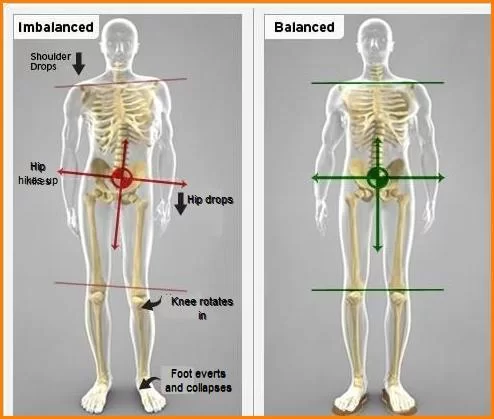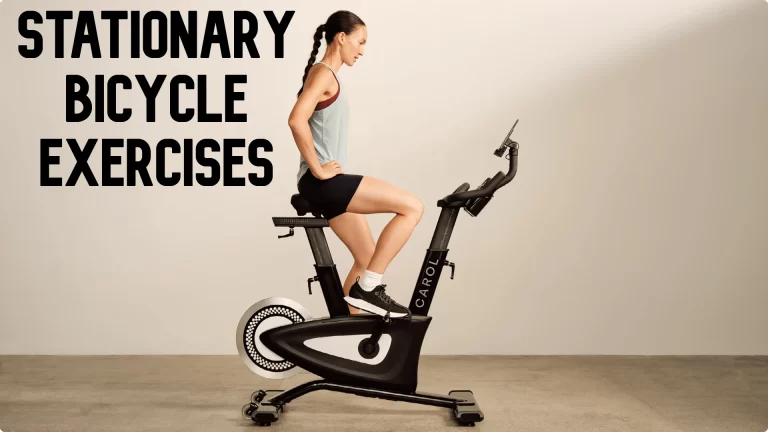How To Fix Lateral Pelvic Tilt?
Lateral pelvic tilt is a common postural issue where one side of the pelvis is positioned higher than the other, potentially leading to various musculoskeletal problems.
Correcting lateral pelvic tilt involves addressing muscular imbalances, improving flexibility, and enhancing overall body awareness.
Table of Contents
A High Hip or Lateral Pelvic Tilt: What Is It?
Many different people may be impacted by high hips. Every customer has a unique body type. They differ in many ways, including bone structure, muscle structure, weight, and height. It is your responsibility as a trainer or coach to create a fitness regimen that takes into account each individual’s unique musculoskeletal structure. One thing to think about is if they have a lateral pelvic tilt, which is another term for a high hip.
One hip sitting higher than the other is known as lateral pelvic tilt. A hip hike is the term used to describe the hip that sits higher. A hip drop is a hip that is positioned lower.
One of the three forms of pelvic tilt is lateral pelvic tilt. Anterior and posterior pelvic tilts are the other two.
The top of the pelvis tilts forward when there is an anterior pelvic tilt. Perhaps this is particularly noticeable in pregnant women. But other individuals may go through it as well. The top of the pelvis tilts rearward when there is a posterior pelvic tilt.
There are instances where structural variations result in the high hip. A case in point is scoliosis. A common description of scoliosis is “sideways curvature of the spine.” Because of this curvature, one hip sits higher than the other.
Leg length disparity is another structural problem that can affect hip alignment. A leg length disparity occurs when the left or right legs are longer than the other. Inequalities in leg length might cause the hip to sit unevenly.
There are functional explanations for lateral pelvic tilt scoliosis and leg length disparity. For example, tight hip flexors might alter the function of the hip muscles. The lower back, leg, groin, and hip are home to the hip flexor muscles. The pelvis may also tilt if one side of the body has weaker gluteus muscles than the other.
Causes for Pelvic Tilt lateral
A variety of factors, such as scoliosis, injuries, imbalanced muscles, and bad posture can cause lateral pelvic tilt.
Inadequate exercise methods, a sedentary lifestyle, and repeated actions at work can all lead to lateral pelvic tilt.
In essence, lateral pelvic tilt results in one side of the pelvis being higher than the other. This might be a small problem, like soreness, or it could be so bad that it makes one leg look shorter than the other.
Bad posture is one of the most frequent causes of lateral pelvic tilt. Improper posture when sitting or standing can lead to lateral pelvic tilt by putting strain on your spine and creating muscular imbalances.
Lateral pelvic tilt can also result from injuries to the hips or lower back when the body shifts weight to one side to compensate for the damage.
Scoliosis, or the sideways curvature of the spine, is another disorder that can lead to lateral pelvic tilt.
This may also result in a tilted pelvis, which can be painful. To avoid more issues and enhance general health and well-being, it’s critical to treat any underlying illnesses or injuries that may be causing lateral pelvic tilt.
Numerous factors can lead to lateral pelvic tilt. Finding the possible cause of the issue is also necessary to solve this one.
Exercises for correcting lateral pelvic tilt are beneficial, but it’s also critical to take steps to avoid this issue from happening again in the future. Simple activities such as lying on your side and watching television might have an impact on the position of your pelvis.
If lateral pelvic tilt is troublesome, on the other hand, it can be brought on by habitual behavior. For instance, bearing weight unevenly distributed may cause pelvic tilt, according to a July 2016 research published in the Journal of Physical Therapy Science.
In particular, lateral pelvic tilt happened when research participants carried 15 percent of their body weight in purses or shoulder bags. However when carrying lighter bags or utilizing backpacks, which provide better weight distribution, this problem was less likely to arise.
Unevenly distributed weight can result in pelvic tilt; shoulder bags and purses are not the only culprits. Lateral pelvic tilt can occur even when a kid is carried on one hip.
Symptoms of Lateral Pelvic Tilt
The most typical signs of lateral pelvic tilt include a perceptible slanting of the shoulders and hips, leg, and hip discomfort, as well as lower back pain. Along with a limited range of motion, people with this illness may find it difficult to walk, stand, or remain still for long periods.
A person’s mental health may be negatively impacted by lateral pelvic tilt in addition to the physical symptoms. Anger, sadness, and frustration are possible outcomes of this condition’s ongoing pain and suffering. A person’s confidence and sense of self-worth may also be impacted since they may have self-consciousness over their looks and posture.
Fortunately, lateral pelvic tilt may be treated with a variety of approaches, such as physical therapy, chiropractic adjustments, and corrective exercise programs. Surgery can be required in some circumstances to address the underlying problem. If you are suffering any of the symptoms linked to lateral pelvic tilt, it is crucial to consult a doctor since prompt treatment can improve results.
Having an out-of-aligned hip may make daily tasks unbearably uncomfortable. Pelvic tilt symptoms include:
- walking imbalanced and with an impression that one leg is longer than the other
- ache in your back and hips weak abs and glutes
- unequal shoulder height and internal leg rotation
- degeneration and herniation of the spinal discs
How can one determine whether they have a pelvic tilt to the side?
To figure out whether your pelvis is biassed:
Position yourself facing a huge mirror, keeping your feet shoulder-width apart.
Put your hand heels on the anterior superior iliac spine, which is the front of your hip bones.
Imagine a horizontal line between your hands, or hold a piece of thread stretched between both of them.
Instead of tilting up or down, the line connecting your hands should be parallel to the ground. Should the line not be parallel, you can have a pelvic tilt to one side.
Professional opinions
You should have a licensed physical therapist assess you if you’re not sure if you have a lateral pelvic tilt or if you don’t feel comfortable making the diagnosis on your own.
It is noteworthy that there are two types of lateral pelvic tilts: “structural” and “functional.” For this reason, you must undergo evaluation from a physical therapist to identify the reason behind your lateral tilt.
A leg length difference, or one leg being longer than the other, or structural scoliosis can result in a structural pelvic tilt. Muscle imbalance or compensation to reduce discomfort is typically the cause of a functional pelvic tilt.
Lateral Pelvic Tilt Exercises
When creating a program to manage posterior pelvic tilt, incorporate these corrective movements into it:
Lying Reverse Leg Raises: By lowering oneself relative to the other due to weaker hips, this exercise will strengthen the weaker side.
Standing Reverse Leg Raise (Glute Kick Back): This exercise corrects unilateral imbalance by strengthening the weaker side.
Clamshell Exercise: Improves balance between your inner and outside legs by strengthening the gluteus medius, a muscle on the outside that helps stabilize your pelvis.
Stretching the Quadratus Lumborum and Oblique Overhead
Leg lifts while lying down: This strengthens the gluteus medius.
Foam roll lower back/quadratus lumborum: Release the erector spinae, lumbar spine, and tight quadratus lumborum pushing on either side.
As usual, be sure you understand the boundaries of your work as a personal trainer. It’s essential to know your legal options while addressing the movement dysfunctions of your clients.
Exercises with detailed explanation for treating lateral pelvic tilt
These exercises may be used at home to help address lateral pelvic tilts.
Leg lifts in reverse
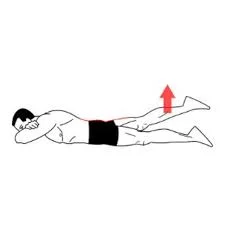
Throughout this workout, your hip ROM will improve and your gluteus muscles will get powerful. It may be difficult at first to do this exercise since the muscles in the hip that sit lower are likely weaker.
- With your hands supporting your forehead and your legs flat on the floor, assume a stomach pose.
- Maintaining straight knees and taut gluteal muscles, raise one leg.
- When your toe touches the floor, lower your leg.
- Perform 12 iterations.
- Repeat after switching legs.
- Use modest, controlled movements to complete this exercise while maintaining a straight spine. Avoid swinging your leg as this may result in back discomfort.
Hike your hips
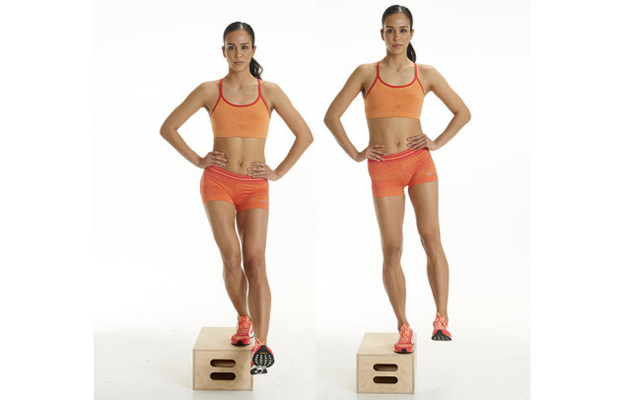
- Enhancing hip and core strength as well as pelvic alignment is possible with this exercise.
- Place your weight on the side of the leg where your pelvis is higher, such as a small step or box. If necessary, grasp onto anything.
- Maintaining a straight spine, push down with your foot to raise the opposing pelvis as high as you can.
- After ten seconds of holding this, go back to your starting position.
- Repeat ten to fifteen times, or until the leg you are standing on becomes tired.
Clamshell
Your gluteus muscles will get stronger and your hip range of motion will be enhanced with this workout.
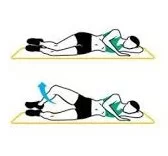
- Lay on your side with your head supported by your bottom arm and both legs bent at a 90-degree angle.
- Roll your upper hip gently forward towards the ground before you begin, and make sure your spine is secure and relaxed.
- Raise your upper leg while maintaining a straight gait.
- After holding for five seconds, bend your knee downward.
- Perform 12 iterations.
- Change positions.
- Make sure you perform this exercise without rotating your spine. Back discomfort and more stress may result from this. Strive for thoughtful, brief motions.
You can extend or draw your legs in closer to your torso. Slightly shifting your position will assist you in activating every muscle in that region.
Adduction of the hips
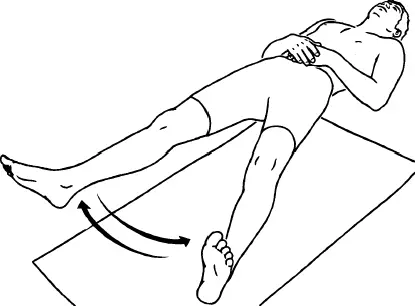
The adductor muscles, which are found within your thighs, will get stronger with this workout.
- Stretching out both legs, lie on one side. Hold your head high with your lower arm.
- With your top leg’s foot on the floor in front of your bottom leg’s knee, cross your top leg over your bottom leg.
- Lift your lower leg as high as is comfortable while maintaining a straight leg.
- After five seconds of holding still, drop your leg.
- Perform 12 iterations.
- Change positions.
- Verify that you are not elevating your leg while bending your hips.
The value of stretching
Underworked muscles will get stronger with these workouts. To be properly balanced, you will also need to stretch the overused muscles.
The Risks and Complications with Untreated Pelvic Tilt
Sciatica, muscular stiffness, and persistent pain are just a few of the consequences that can arise from untreated lateral pelvic tilt. Additionally, it may raise the chance of acquiring more serious illnesses including arthritis and herniated discs, which can worsen already existing problems and limit mobility and quality of life.
Untreated pelvic tilt can harm mental health in addition to these physical issues. Depressive, anxious, and frustrated sentiments might result from chronic pain and restricted movement. Seeking therapy for pelvic tilt is crucial for enhancing general well-being as well as physical health.
Non-Surgical Treatment Options for Lateral Pelvic Tilt
For lateral pelvic tilt, non-surgical treatment options comprise yoga, Pilates, massage therapy, chiropractic adjustments, and physical therapy. By enhancing muscular strength, flexibility, and balance, these methods seek to enhance alignment and lessen pain and suffering.
One popular non-surgical treatment for lateral pelvic tilt is physical therapy. A physical therapist can design a customized workout regimen to work on certain muscles and enhance posture in general. This might involve stretches to increase flexibility as well as exercises to strengthen the hip flexors, glutes, and core muscles.
For people with lateral pelvic tilt, chiropractic treatment may be helpful in addition to physical therapy.
The spine and pelvis are realigned by chiropractors using manual manipulation techniques, which can assist in improving general alignment and lessen pain and suffering. Together with chiropractic adjustments, massage treatment can help loosen up tense muscles and increase blood flow.
Massage Treatment
A massage therapist is able to perform soft tissue manipulation to help you relax and recover by increasing blood flow to the injured hip region and loosening up your tense muscles.
Some symptoms can be relieved by detaching deep tissues in the quadratus lumborum and spinal extensors. This will also restore your range of motion, allowing you to begin an effective preventative program by strengthening key muscles via exercise.
Conclusion
In conclusion, fixing lateral pelvic tilt requires a multifaceted approach that includes targeted exercises, stretches, and postural adjustments. Identifying and addressing muscular imbalances, improving flexibility, and enhancing overall body awareness are crucial components of a personalized plan.
Seeking guidance from healthcare professionals or qualified fitness experts can ensure an effective and tailored strategy to correct lateral pelvic tilt, promoting better posture and reducing the risk of associated musculoskeletal issues.
FAQs
These might entail having the spinal abnormality surgically corrected, using braces or corsets, or, in more severe situations, both. To treat lateral pelvic tilts, which are functional abnormalities brought on by muscular tension, physical therapy, stretching, and occasionally muscle relaxants are utilized.
The pelvic floor muscles, transverse abdominis muscles, erector spinae muscles, and diaphragm are among the core muscles that are out of harmony with your leg muscles.
What exactly Is Pelvic Tilt and How Can It Be Corrected?
The hip flexor and hip extensor muscles play a major role in many pelvic tilt problems. You may anticipate additional muscles in the pelvic region to stiffen up since these muscles relate to the pelvis and lower back. The rectus femoris, quadratus lumborum, and psoas major are a few of these muscles.
Definition. The angle formed by a line drawn from the sacral endplate midway to the centers of the bifemoral heads and the vertical axis is known as pelvic tilt (PT), and it is a position-dependent characteristic. The typical pelvic tilting ranges are 8.9 ± 4.5° for the rear and 13.0 ± 4.9° for the anterior.
Your spine connects your pelvis to your shoulders and upper back. It’s attached to your legs as well. These regions can occasionally exhibit the consequences of unequal hips: Uneven shoulders: You may have an uneven shoulder appearance.
References
- 5 Lateral Pelvic Tilt Exercises. Healthline. https://www.healthline.com/health/fitness-and-exercise/lateral-pelvic-tilt-exercise
- What Contains Pelvic Tilt and How Can It Be Corrected? | https://www.issaonline.com/blog/post/pelvic-tilt-what-is-it-and-how-do-you-correct-it
- How to Correct High Hip (Lateral Pelvic Tilt) in the Gym | https://www.issaonline.com/blog/post/how-to-correct-high-hip-lateral-pelvic-tilt-in-the-gym
- Understanding And Treating Lateral Pelvic Tilt | Allo Health – Better Sex, Backed by Science.
- https://www.allohealth.care/healthfeed/sexual-wellness/lateral-pelvic-tilt
- Triggers, the Process of Diagnosis, and a Three-Step Fix for Lateral Pelvic Tilt.
- https://victoremgear.com/blogs/resistance-training/lateral-pelvic-tilt

